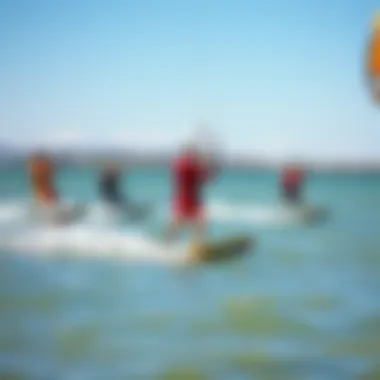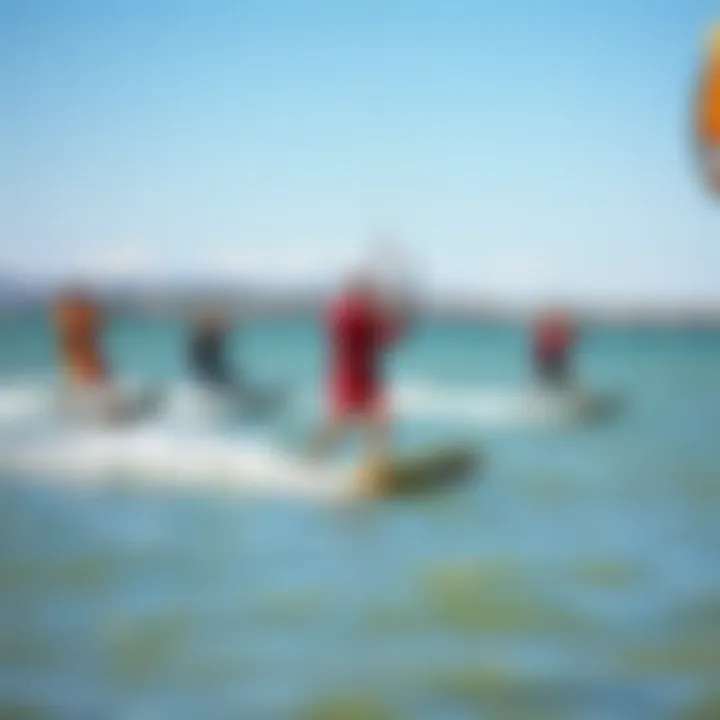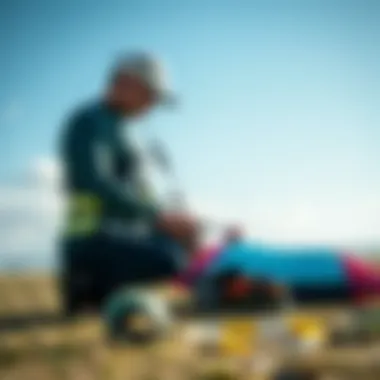Ultimate Guide to Buying Surfing Kites


Intro
Kiteboarding has carved out its unique niche in the world of water sports, blurring the lines between surfing and traditional kite flying. As enthusiasts gather at beaches worldwide, the thrill of capturing wind power and gliding over waves becomes irresistible. But before you launch into the waves, the most critical step lies in selecting the right equipment.
Navigating the myriad of kites on the market can be as confusing as untangling a fishing line. Knowing what to look for ensures a smoother ride and a safer experience. From discerning kite types to understanding specifications, this guide aims to equip you with knowledge, no matter your skill level.
Whether you're a novice just dipping your toes or a seasoned pro searching for the latest gear upgrades, grasping the essentials of kiteboarding gear will dramatically enhance your experience. Let’s embark on this journey toward finding the perfect surfing kite that matches your individual riding style and aspirations.
Understanding Surfing Kites
Diving into the world of surfing kites is akin to setting the sails for a journey across the vast ocean; clarity in your choices ensures smoother winds ahead. This section is pivotal because understanding kites is the foundation of any successful kiteboarding experience. It helps enthusiasts grasp the essential elements, benefits, and considerations that come into play when selecting the right gear.
Definition and Purpose
Surfing kites, also known as kitesurfing kites, are specially designed inflatable or foil structures that harness the power of the wind to propel riders across water.
To put it simply, these kites serve a dual purpose: they create lift and provide control over the board, allowing riders to catch waves and perform tricks. With advancements in technology, today’s kites are more efficient and user-friendly than ever before. Here’s what sets them apart:
- Lift generation: Smithing a balance between power and control is crucial for any kite. The lift produced by the kite allows riders to jump higher and glide smoother.
- Reactivity: Well-designed kites respond quickly to the slightest shifts in wind, providing riders with the ability to make split-second decisions.
- Stability: A stable kite can drastically improve a kiter's experience, making the ride safer and more enjoyable.
In essence, understanding what a surfing kite is and what it does creates a pathway for both novice and experienced kiteboarders. It also helps in fostering a greater connection with the sport itself, enabling riders to make informed decisions that enhance their skill level and enjoyment.
The Evolution of Kitesurfing Gear
Kitesurfing gear has come a long way, evolving from rudimentary designs to today's sophisticated equipment. In the beginnings, kites were simple, often homemade, and made from materials that did not prioritize durability or performance. But with time, innovation took the helm.
Here are some notable changes and advancements:
- Material advancements: Older kites were often made from heavy materials, detracting from performance. Modern kites utilize lightweight, durable fabrics that resist tearing and increase longevity.
- Inflatable kites: Leading Edge Inflatable kites have changed the game entirely, making the experience more user-friendly and significantly safer. They are easier to launch, land, and control.
- Safety features: Earlier kites lacked crucial safety mechanisms. Now, almost all modern kites come with built-in safety systems to ensure riders can quickly depower the kite or release it entirely.
The journey of kitesurfing gear demonstrates that with each revolution in design and technology, opportunities for enhancing riding experiences expand. By understanding this evolution, enthusiasts can appreciate the level of sophistication present in today's equipment and be more confident as they venture into the sport.
Types of Surfing Kites
Understanding the various types of surfing kites is fundamental for anyone looking to thrive in the sport of kiteboarding. Each type has specific characteristics and advantages, catering to different skill levels, conditions, and riding styles. Choosing the right kite plays a massive role in performance, safety, and the overall enjoyment of riding. As we navigate the waters of kitesurfing gear, a thorough grasp of these types will ensure you make better decisions, transforming every session into a memorable experience.
Foil Kites
Foil kites, with their unique design, are crafted using a series of air chambers that fill with air when in motion. This engineering essentially creates a wing that allows them to handle a variety of wind conditions well. A significant advantage of foil kites is their ability to stay aloft even in lighter winds, making them an excellent choice for beginner and intermediate riders.
Some benefits of using foil kites include:
- Lightweight Construction: They tend to be easier to carry, which is great for those long treks to the beach.
- Stability and Control: Once in the air, these kites provide excellent stability, which aids in building confidence for new riders.
- Versatility: They're suitable for various conditions, including surf and flat water.
However, novices should note that they come with a learning curve. The initial take-off can be trickier compared to other types. But with practice, they reward users with a smooth ride.
Leading Edge Inflatable (LEI) Kites
Leading Edge Inflatable kites are a staple in the kitesurfing community, boasting a robust design characterized by an inflatable leading edge and struts. This construction gives them remarkable rigidity, allowing for better performance in high winds.
Key points to consider about LEIs:
- Ease of Relaunch: Should you crash, LEIs typically have a straightforward relaunch process, which is a godsend for beginners.
- Support in Strong Winds: They can handle gusty conditions effectively, appealing to more advanced riders who seek adrenaline in rough weather.
- Wide Application: Ranging from freestyle tricks to waves, LEIs serve a broad spectrum of riding styles.
They do, however, require more maintenance compared to foil kites. Keeping them clean and storing them right will prolong their life. So, riders should be ready to invest time in care.
Hybrid Kites
Hybrid kites merge features of foil and LEI designs, attempting to strike a balance between the two worlds. They present an appealing option for those who want the best of both worlds. One of their notable perks is their adaptability across different conditions, offering versatility in use.
Some notable features include:
- Compact Design: Usually lighter and less bulky than LEIs, making them easy to handle.
- Speed and Responsiveness: Hybrid kites often respond well to rider input, making them ideal for freestyle and wave riding.
- Wide Wind Range: They perform admirably in diverse wind conditions, making them reliable for various riders.
Nevertheless, hybrid kites often require a bit more skill to fully exploit their potential. They might not be the best choice for complete newcomers but can be beneficial as riders progress.
In summary, choosing between foil kites, LEIs, or hybrid kites very much hinges on your intended riding style and the conditions you prefer to kite in. Each option has merits that can complement your skill level and scenario, so it's wise to assess your priorities before making a purchase.
Key Specifications to Consider
When diving into the world of surfing kites, it's crucial to grasp the finer aspects that define performance, safety, and overall enjoyment. Key specifications are the backbone of any kite purchase. They serve not just to satisfy personal preferences but to align with the conditions you'll encounter on the water. Understanding these elements ensures you find a kite that meshes well with your riding style and environment, making every session more productive.
Size Variations
The size of a kite plays a pivotal role in how it performs under different wind conditions. Generally, kites come in a variety of sizes, ranging from 3 meters to more than 17 meters. Here’s why size really matters:
- Smaller Kites (3-7m): Best suited for high winds and advanced riders seeking agility and speed. These are easier to manage but can be tricky for beginners.
- Medium Kites (8-12m): Commonly preferred by most kiteboarders, these sizes offer a balance between power and control. They’re versatile enough for various conditions.
- Larger Kites (13-17m): Ideal for light winds, allowing less experienced kiteboarders to stay on the board longer. However, bigger means more pull, so be wary of overpowering strength.
In essence, considering the size is a big deal. If you pick a kite that’s too small for a given wind condition, you’re going to be left floundering. Pick one that’s too large, and you might find yourself struggling to control it, which isn’t a pleasant experience.
Material Quality
The material used in crafting a kite directly influences its durability and performance. Kite materials have progressed significantly over the years, with advancements focusing on enhancing strength while minimizing weight. Here are some key points regarding material choices:
- Ripstop Nylon & Polyester: Most kites use these materials due to their light weight and resistance to tears. Ripstop nylon tends to be the go-to option, particularly for its robustness.
- Laminated vs. Non-Laminated Fabrics: Laminated fabrics, though pricier, provide superior performance by resisting water absorbency and maintaining their rigidity in the air. Non-laminated fabrics can work just fine but may not hold up as long.
- Reinforcement Techniques: Look for kites with reinforced seams and stress points. These features typically mean a longer lifespan and better resistance to wear and tear from constant usage.
In terms of choosing wisely, remember the phrase, "you get what you pay for." Investing in a kite with high-quality materials can save you from frequent repairs or replacements down the line.


Wind Range Compatibility
A kite’s wind range compatibility is a decisive factor that affects its functionality and your enjoyment level while riding. Each kite has its own wind range specified by the manufacturer, which usually outlines the minimum and maximum wind conditions for safe operation.
Here’s a quick rundown:
- Low-End Range: The lightest wind speeds a kite can operate in; too light, and the kite won’t fly properly.
- Optimal Range: The sweet spot where the kite performs at its peak. This is where you’ll get that beautiful, smooth lift and ride.
- High-End Range: These are often challenging conditions; going beyond this limit might result in overpowering and potential loss of control.
Understanding the wind compatibility for your chosen kite can save you from those uncomfortable "what was I thinking" moments. A kite that's mainly tailored for high winds shouldn't be your choice on an overly calm day—and vice versa.
"Choosing the right kite is like picking the perfect partner; you need compatibility for a successful ride."
With these key specifications at the forefront of your decision-making process, you’ll be equipped to select a kite that not only meets your individual style but also enhances your overall experience on the water.
Evaluating Brands
When it comes to selecting the ideal surfing kite, assessing brands is a crucial step in the journey. In the fast-paced world of kiteboarding, the brand you choose can significantly impact your overall experience, safety, and performance. It’s not just about picking a name that looks good on social media, rather, it’s about reliable quality, innovation, and longstanding reputation in the industry. Here’s why evaluating brands deserves your attention:
- Reputation and Trustworthiness: Well-established brands often have a solid reputation, built over years of delivering quality products. They are more likely to stand behind their gear and offer warranties or support when needed. Newer brands might promise the moon but may lack the same level of customer service or quality assurance.
- Innovation and Technology: The kiteboarding world is ever-evolving, with technological advancements influencing the performance of kites. Established players invest significantly in research and development, leading to innovative designs and features. Considering a brand's commitment to innovation can give you insights into what you might expect from their offerings.
- User Reviews and Community Feedback: Considering what others within the kiteboarding community are saying can inform your decision. Online forums and discussions on platforms like Reddit or specialized kiteboarding Facebook groups provide ample user reviews, showcasing real experiences with specific brands.
"A kite's brand can mean the difference between navigating the waves with confidence and feeling like you’re battling the sea without a lifeboat."
Established Players in the Market
Diving into the realm of established kiteboarding brands opens up a world of recognized names that have earned their stripes. Here are a few noteworthy examples:
- Naish: Renowned for its cutting-edge technology and reliable performance, Naish has been a leader in the industry for decades. Their kites tend to balance stability and agility, making them a top choice for many riders.
- Cabrinha: Known for innovations in kite design, Cabrinha offers a range of kites aimed at different skill levels. Their reputation for durability and strong build quality precedes them in many discussions among kiteboard enthusiasts.
- Slingshot: Slingshot is celebrated for its commitment to producing durable and high-performance kites. Their products often come with unique design elements, appealing to intermediate and advanced practitioners alike.
Exploring these established brands gives potential buyers a better chance of investing in equipment that has been tested and trusted by many.
Emerging Brands Worth Noticing
While established players dominate the market, emerging brands bring fresh perspectives and innovative designs to the table. They often enter the scene with unique features or approaches that can challenge the status quo:
- Duotone: Originally part of North Kiteboarding, Duotone emerged as a separate brand focusing on quality and performance. Their designs often appeal to a broad audience, from beginners to advanced riders.
- Soul Kites: An upstart that caught many by surprise with its focus on eco-friendly materials and practices. If you’re environmentally conscious, this brand could be a perfect fit for you.
- Ozone: Though not the newest name, Ozone continues to innovate with kites that prioritize safety and performance, making them a brand worth considering.
Being open to these newcomers can lead to discovering remarkable equipment that fits your needs while also supporting a diverse range of brands in the industry.
Finding the Right Fit
Finding the right fit in kiteboarding is akin to finding the perfect pair of shoes. It’s not just about aesthetics or trendy colors; it’s about how well the gear aligns with your personal riding style and skill level. Delving into the nuances of this topic, you’ll realize it plays a pivotal role in not just enhancing performance, but also ensuring safety and maximizing enjoyment while riding the waves.
When selecting a kite, consider its compatibility with your unique riding approach. Just as a surfer tailors their board to the waves, kiteboarders must align their kite choice with how they intend to ride. It's essential to synthesize your aspirations with practical choices to ultimately elevate your kiteboarding experience.
Assessing Personal Riding Style
Your riding style, distinct as a fingerprint, dictates several key factors in your choice of kite. Are you a free-rider who enjoys cruising along the coastline, or do you get your thrills from freestyle tricks? The characteristics of different kites cater to these varying approaches:
- Free-riding Kites: Generally, these kites offer stability and a bigger wind range. If you’re someone who loves to float across the water, cruising at high speeds and enjoying the serene feeling of gliding, a free-riding kite is what you're after.
- Freestyle Kites: If you find yourself tangled up in the pursuit of high-flying tricks, look into kites designed specifically for this purpose. These often feature a more direct feel and a responsive design to facilitate swift maneuvers.
- Wave Kites: If you aspire to ride waves, consider a wave kite, as they’re tailored for responsive handling and can adapt to rapidly changing conditions.
Understanding your individual style will not only help you choose a kite that enhances your performance, but it can also save you from potential frustration down the line.
Adjusting for Skill Level
Skill level is another fundamental aspect that influences your kite choice. Newbies might feel overwhelmed by the vast selection of kites that promise performance and excitement. Here’s where careful consideration comes into play:
- Beginners: If you're just starting out, opt for a kite that’s user-friendly with predictable power and stability. These kites often have a larger wind range and a gentle pull, allowing you to focus on mastering your basics. Look for brands that offer beginner-friendly options.
- Intermediate Riders: As you progress, you'll want a kite that challenges you but also gives you the reliability you need. Intermediate-level kites strike a balance between performance and ease of use. They provide the lift needed for jumps and tricks while maintaining control.
- Advanced Riders: At this level, performance kites take center stage. You may want advanced features for specialized riding styles, focusing on competition-level kites that ensure high response rates and agility during complex maneuvers.
Choosing a kite that resonates with your skill development journey is not merely a choice; it’s an investment in your growth as a kiteboarder. After all, the better you match your gear to your level, the more confidence you gain, allowing for a smoother progression in the sport.
In kiteboarding, the right kite isn’t just about brand or price; it’s about understanding what works best for your unique combination of style and skill.
This thoughtful approach to finding the right fit ensures you’ll not only ride efficiently but also maximize the sheer joy of being on the water.
Safety Features in Kites
When stepping into the world of kiteboarding, safety takes precedence. Understanding the safety features in kites isn't just a matter of caution; it's an absolute necessity that can be a game-changer for your riding experience. It’s crucial for beginners who might feel like a fish out of water, and equally important for seasoned riders who take on new challenges.
Built-in safety systems and adherence to safety standards can significantly reduce the risk of accidents. The water can be unpredictable, and having a reliable safety mechanism in place can mean the difference between a fun session and one that you’d rather forget.
Built-in Safety Systems
Most modern kites incorporate numerous built-in safety systems that are designed to protect you while you're out on the water. These systems include:
- Quick Release Systems: They allow you to detach from the kite in emergencies, ensuring you can get free quickly. Just imagine the scenario where strong winds pick up unexpectedly. You would want to release yourself from tension without fuss.
- Depower Features: This function lets you reduce the kite's power quickly, which can help in managing tricky wind conditions. The adjustability can help you regain control, especially when gusts hit like a freight train.
- Reinforced Leading Edge: A durable leading edge can handle impacts better and reduce the risk of tear-outs. A kite that withstands surprises is worth its weight in gold, especially when riding in rocky waters or crowded beaches.
These safety systems are not just a fluffy marketing strategy. They enhance your overall kiteboarding experience and give you critical tools to manage emergency situations more effectively.
Safety Standards and Certifications
When it comes to kiteboarding gear, not all products are created equal. Safety standards and certifications are vital factors that can guide your purchasing decisions. Opting for kites that meet recognized industry standards ensures you’re not just buying a pretty piece of fabric.
- ISO Certification: This shows that the kite has been tested for quality and safety. If you spot this mark, you can ride with the confidence that it has passed rigorous testing.
- CE Marking: In Europe, kites bearing the CE mark meet safety requirements set by the European Union. This provides you with additional assurance that the kite adheres to essential regulations.
- Manufacturer Warranties: A decent warranty often indicates the manufacturer's trust in their own product’s quality. If they’re willing to stand behind it, it's a good sign you may have a reliable kite on your hands.
In short, safety features establish the groundwork for a worry-free experience while kiteboarding. Ensure that you take the extra step to research kites on the market thoroughly. Some brands might trumpet features, but a lack of proper certifications can cast a shadow over their reliability. As they say, a ounce of prevention is worth a pound of cure.
Maintenance and Care for Kites


Taking proper care of your kiteboarding gear is as crucial as selecting the right kite in the first place. Just like any other high-performance equipment, surfing kites require regular maintenance and attentive care to ensure they perform optimally throughout their lifespan. Neglecting their upkeep can lead to unforeseen accidents, subpar performance, and ultimately, an early retirement of your kite. It’s a cornerstone for both safety and enjoyment on the water.
When discussing maintenance and care, there are several key points to keep in mind, including cleaning procedures, storage techniques, and how to best protect your investment from wear and tear. Keeping your gear in top shape not only enhances your riding experience but also saves you money in the long run. A little TLC goes a long way, ensuring that each kite session is filled with exhilaration rather than frustration due to equipment failure.
Cleaning Procedures
Kites are exposed to saltwater, sand, and dirt, which can accumulate and lead to fabric degradation over time if not addressed regularly. The first step in maintaining your kite is establishing a diligent cleaning routine. After each session, it’s wise to rinse the kite with fresh water to remove any accumulated sand and salt. Just spraying it down with a hose won’t cut it; you want to ensure that you wipe down the more delicate areas such as the seams and the canopy fabric.
Here are some specific steps for effective cleaning:
- Rinse Thoroughly: Begin by running fresh water over the entire kite. Pay attention to areas that tend to gather debris.
- Use a Soft Cloth: Gently scrub the surface with a soft cloth or sponge to lift off any stubborn dirt without damaging the material.
- Avoid Soaps and Detergents: These can strip the protective coatings on the kite fabric, so it’s best to keep it simple and stick to clear water.
- Dry Properly: After washing, make sure to dry the kite completely before folding it. Hang it in a shaded area and never expose it to direct sunlight for prolonged periods to prevent fading.
Implementing these cleaning steps will help to extend the life of your kite, maintain its performance capabilities, and keep it looking fresh.
Storage Techniques
Proper storage is another pillar of kite care. Once you've taken the time to clean your kite, the way you store it can be just as important. Storing kites incorrectly can lead to creases, bending, and tears, which might affect their aerodynamics. Keep in mind these fundamental practices to store your kite safely:
- Use a Suitable Bag: A kite can get easily damaged if tossed into a corner without protection. Investing in a quality kite bag designed for storage can help protect it from physical damage.
- Avoid Folds: When packing your kite, avoid storing it folded. Instead, roll it up softly to prevent creases, or store it inflated during long periods to maintain its shape.
- Climate Control: Find a cool, dry place for storage. Basements often experience fluctuating humidity, which can affect the materials of your kite, so aim for a well-ventilated area.
- Keep Away from Sharp Objects: Make sure to store your kite away from anything that could puncture or tear the fabric, including tools or rough surfaces. Keep it high and dry, away from pets or curious little hands.
By putting thought into both cleaning and storage, kiteboarders can maintain the integrity and performance of their kites. Not only does this prolong the lifespan of the equipment, but it also enhances the overall experience on the water.
Purchase Platforms
When it comes to buying a surfing kite, the platform you choose can significantly influence your overall experience, from selection to support after the sale. Distinguishing between different purchase platforms is crucial for kiteboarders of all levels, whether you’re a beginner strapping on a kite for the first time or a seasoned pro looking for your next piece of gear.
Online Retailers vs. Local Shops
In the digital age, online retailers have become giants in the kiteboarding marketplace. Websites such as Amazon, and Ebay, or dedicated sites like Kiteboarding.com offer an extensive selection of kites from various brands. The beauty of online shopping is that you can easily compare prices and read reviews from other users without stepping foot outside. This convenience, however, comes with its own set of challenges. You might find a great deal, but you miss the tactile experience of handling the kite or talking to knowledgeable staff, which local shops can offer. Local shops, on the other hand, foster a community. They often provide an environment where you can ask specific questions, try on equipment, and sometimes even get a demo before you buy. Remember, the advice from an experienced shopkeeper can prove invaluable, especially for newcomers.
- Pros of Online Retailers:
- Cons of Online Retailers:
- Pros of Local Shops:
- Cons of Local Shops:
- Vast selection of products.
- User reviews to gauge quality.
- Competitive pricing.
- No in-person examination of the equipment.
- Potential for longer shipping times.
- Personalized customer service.
- Immediate access to products.
- Opportunity to test equipment firsthand.
- Limited selection compared to online.
- Typically higher prices.
Both platforms have their strengths and weaknesses; hence, balancing your choice based on immediate needs and long-term goals may prove the best approach.
Second-Hand Market Considerations
The second-hand market can be an intriguing avenue for kiteboarding enthusiasts. If you’re looking to get into the sport without breaking the bank, buying previously owned gear can provide access to high-quality products at a fraction of the price. Websites such as Craiglist, and Facebook Marketplace can offer some hidden gems, but proceed with caution.
A few considerations for the second-hand market include:
- Condition of the Kite: Always inspect the kite thoroughly for any signs of wear, tear, or damage. Look for leaking bladders and check the stitching.
- Age of the Equipment: Older models may not have the latest features and could potentially be less safe due to wear.
- Brand Reputation: Ensure that you’re buying from a known brand that maintains quality; some cheap kites can quickly lead to poor performance or safety issues.
- Return Policy: If buying from a local seller or online, verify what kind of return policy they offer. If you find out later that the kite has deeper issues than expected, a return policy can save the day.
In summary, whether you opt for online retailers, local shops, or dive into the second-hand market, being aware of what each offers is crucial to making a knowledgeable choice. This way, you're not just selecting a kite; you’re investing in countless rides and experiences that lie ahead.
Community Resources
Community resources are invaluable in the world of kiteboarding, offering a wealth of knowledge, support, and opportunities for enthusiasts at all levels. These resources not only enhance the kitesurfing experience but also foster connections among veterans and newbies alike. As kiteboarding continues to grow, the importance of community becomes more pronounced, allowing individuals to share insights, experiences, and advice. Exploring avenues such as local schools, training centers, and online forums and groups provides essential guidance and camaraderie for kite enthusiasts.
Local Schools and Training Centers
Local schools and training centers play a crucial role in shaping the skills and understanding of kiteboarding. These establishments are often the first point of contact for beginners seeking to learn the basics of kiting. Lessons offered at these centers typically cater to various skill levels, ensuring that each participant receives tailored instruction that addresses their specific needs.
The advantage of local schools is not just the education they provide but also the atmosphere they create. Beginners can benefit from hands-on training, where instructors guide them through the nuances of body positioning, controlling the kite, and understanding wind patterns. Engaging with instructors and fellow learners fosters a supportive environment, which can often alleviate the daunting nature of mastering a new sport.
Additionally, training centers frequently provide access to high-quality equipment, which is essential for those who may not yet have their own gear. This access means that learners can practice with the latest technology, optimizing their learning process and ensuring they develop proper techniques from the get-go.
“Investing time in quality instruction can transform your approach to kiteboarding, setting the stage for a safer and more enjoyable experience.”
These local hubs also serve as community platforms, where kiteboarders can connect socially beyond lessons. Events, competitions, and meet-ups organized by the centers create an engaging atmosphere that can encourage individuals to push their limits and set new goals.
Online Forums and Groups
In today's digital age, online forums and groups have become an integral part of the kiteboarding community. These platforms offer a space where enthusiasts can share experiences, troubleshoot issues, and discuss all things related to kiting. The wealth of knowledge shared in these online spaces can be immense, especially for those not located near local schools or training centers.
On platforms like Reddit or dedicated Facebook groups, kiteboarders can indulge in discussions ranging from equipment recommendations to tips on techniques. This open exchange fosters a sense of belonging and connection among kiteboarding enthusiasts, regardless of geographical boundaries. Additionally, they serve as a valuable resource for advice on current weather conditions or local spot recommendations, ensuring that riders always find the best conditions.
Beyond technical discussions, online groups often boast segments dedicated to safety and conservation. This helps raise awareness about the environmental impacts of kiteboarding, encouraging members to adopt more sustainable practices.
Some key advantages of online forums include:
- Immediate access to a diverse range of opinions and experiences.
- Ability to ask questions and get quick responses from community members.
- A platform for sharing videos, tutorials, and articles that enhance learning.
- Networking opportunities with other kiteboarders, regardless of their location.
As kiteboarding evolves, these community resources are paramount in supporting both the growth of the sport and individual kiteboarder journeys. Having a solid foundation of local and online resources greatly enhances the kiteboarding experience for everyone involved.
Environmental Considerations
In the world of kiteboarding, where adrenaline runs high and the ocean often calls, there’s a pressing need to reflect on the environmental impact our sport exerts on nature. The very essence of kiteboarding involves the delicate relationship between man and the elements, specifically water and wind. As kiteboarders, enthusiasts, and instructors, we have a responsibility to make our passion sustainable and to ensure that kiteboarding flourishes in harmony with the environment.
Sustainable Materials


When purchasing a new kite, one crucial aspect to consider is the materials used in its construction. Modern manufacturers have started to step up to the plate by utilizing sustainable materials in their products. These materials reduce the environmental toll of production processes while enhancing the longevity of the kites, which is always a plus in the maintenance department. Here are a few noteworthy options often seen:
- Recyclable Fabrics: Fabrics made from recycled polyethylene (rPET) or ripstop nylon minimize waste and offer robust performance.
- Natural Components: Some companies are experimenting with bio-based materials, which can lessen their carbon footprint significantly.
- Non-toxic Coatings: Eco-friendly coatings reduce hazardous waste and are safer for the environment, allowing you to glide through your stunts without causing undue harm.
Investing in kites made from these materials can encourage companies to continue their commitment to sustainability. When we opt for these products, not only are we supporting a cleaner planet, but we're also promoting innovations that can lead to further advancements in kiteboarding gear.
Minimizing Impact on Nature
Another aspect of being a responsible kiteboarder is understanding the impact our activities can have on natural habitats. Water bodies—be they oceans, lakes, or rivers—host diverse ecosystems that deserve our vigilance. Here are some actionable strategies for minimizing our footprint:
- Respect Wildlife: Be aware of local fauna, particularly during breeding seasons. Maintain distance from nesting birds or aquatic wildlife that could be disturbed by your presence.
- Practice Cleanliness: Always collect your litter—kiteboarding gear can sometimes lead to unexpected waste, and leaving trash behind can harm marine life.
- Choose Locations Wisely: Opt for areas less frequented by others if possible. This helps to keep the burden of our sport lighter on the environment, allowing more natural tranquility.
- Support Conservation Efforts: Participate in community clean-up initiatives or reef restoration projects. Engaging actively in these efforts showcases the spirit of kiteboarding positively contributing to preserving the environments we cherish.
"We must be the change we wish to see in the world." - Mahatma Gandhi. In this light, every kiteboarder can make a significant impact by being both an enthusiast and a guardian of nature.
By choosing sustainable materials and being mindful of our practices, kiteboarders can enjoy their pursuits while playing an active role in preserving the beauty of nature. Making these conscious decisions isn’t just about today; it's paving the way for future generations to experience kiteboarding in its purest form.
Emerging Trends in Kiteboarding
The world of kiteboarding is constantly evolving, and staying updated on the latest trends is essential for both enthusiasts and professionals alike. Emerging trends not only influence the way kiteboards are designed and manufactured but also affect riding experiences, safety, and overall enjoyment on the water. With each advancement, whether it be in technology or design, kiteboarders gain new tools and options that can enhance their skills, performance, and connection to the sport.
Understanding these trends can help consumers make informed choices when purchasing kites, ensuring they invest in products that best suit their needs and riding styles. Below, we delve into two significant aspects of these trends: technological advancements and design innovations.
Technological Advancements
The integration of advanced technology into kiteboarding gear has opened up a new chapter in the sport. One major trend involves the use of smart materials that can adjust their flexibility and shape according to wind conditions. This flexibility allows for greater control and performance, adapting to what nature throws your way. Advanced sensors and data analytics often provide riders with feedback on their performance, which can be invaluable for those aiming to push their limits.
Also noteworthy are the enhancements in kite control systems. Many brands have developed more intuitive bar systems that improve reaction times to changes in wind speed. This can reduce the risk of accidents and improve the overall riding experience.
Here are some noteworthy technological features to keep an eye on:
- Progressive depower mechanisms that allow for easier control of lift.
- Integrated GPS technology for tracking performance metrics.
- Lightweight fabrics that increase durability without adding bulk.
These technological strides not only enhance the skill set of riders but also make kiteboarding more accessible for newcomers.
Design Innovations
Design innovation goes hand-in-hand with technology; it represents the fusion of functionality and artistry in kiteboarding equipment. One of the most exciting trends involves aesthetically pleasing designs while maintaining impeccable performance standards. Artists and designers are collaborating with manufacturers to create stunning graphics on kites and boards that reflect a rider's personal style.
Moreover, the shape and structure of kites are becoming more refined, focusing on aerodynamics. Kites with a delta shape or variations that optimize wind capture are becoming commonplace. This leads to improved lift and stability, especially in gusty conditions. Furthermore, brands are experimenting with different profiles and leading edges to enhance performance on both flat water and wave settings.
Additionally, many companies are prioritizing sustainability in their design process. The increasing use of recycled materials in production is a testament to the kiteboarding community's commitment to the environment. Expected design features in upcoming models include:
- More eco-friendly manufacturing processes.
- Easier repair options, making longevity a priority.
- Customizability, allowing riders to adjust the aesthetic and performance to their liking.
"Innovations in design and technology have redefined the kiteboarding experience, making it safer, more enjoyable, and more personalized than ever."
The trends in kiteboarding reflect a dynamic sport that continuously adapts and evolves. Whether you are a seasoned rider or just dipping your toes into the world of kiteboarding, being aware of these changes can significantly influence your choices, enabling you to not just ride but thrive in this exhilarating sport.
Future of Kiteboarding Equipment
The future of kiteboarding equipment holds substantial significance in the context of this article as it stitches together various threads of technology, design, and rider experience. Understanding where the industry is headed enables enthusiasts and professionals alike to make informed choices, keeping their gear in sync with evolving standards. The infusion of next-gen materials and design philosophies is reshaping the landscape of kiteboarding, crafting tangible benefits while also posing unique considerations.
As the sport gains traction worldwide, we can expect continual innovations, making it imperative for riders to stay informed. The increasing accessibility of kiteboarding equipment, paired with improvements in performance and safety, ensures that the next generation of kiteboarders is well equipped for adventure.
Predictions for Industry Growth
Industry experts predict that kiteboarding will see steady growth fueled by rising participation rates and advancements in equipment technology. More locations are becoming kiteboarding friendly, with schools popping up in previously underexplored areas, facilitating diverse experiences for riders.
The average annual growth rate of the global kiteboarding market is estimated to hover around 8-10% in the upcoming years. Here are a few contributing factors to consider:
- Increased Awareness: As more people discover the thrill of kiteboarding, interest is surging. Social media platforms and viral videos are showcasing real-time experiences that have elevated the sport's profile.
- New Demographics: The sport is welcoming participants of various age groups, including families and professionals looking for recreational activities.
- Enhanced Technology: With ongoing research and development, manufacturers are producing lighter, more durable kites that perform reliably across diverse wind conditions.
These elements not only show promise for economic growth but also suggest a maturing market that prioritizes quality and safety alongside exhilarating experiences.
Potential Market Disruptors
In gearing up for the future, potential disruptors could reshape the kiteboarding business landscape significantly. Staying vigilant for trends and shifts in consumer preferences is vital. Several disruptors are gaining traction:
- Sustainability Practices: With an increasing focus on environmental responsibility, brands integrating eco-friendly materials into their kites stand to gain a competitive edge. The kiteboarding community is becoming more aware of its ecological footprint, and brands that align with these values will resonate well.
- Digital Transformation: E-commerce continues to reshape how products are marketed and sold. Companies engaging in innovative digital marketing strategies, such as virtual try-ons, could lead the way in attracting more customers.
- Customization Trends: Riders are increasingly looking for gear that reflects their unique style and preferences. Offering customizable options in kites or harnesses might set a brand apart, catering to the desire for individuality.
"Adaptation, as any experienced kiteboarder knows, is key to navigating both the winds and the waves of change."
For further insights and community discussions, you can refer to resources like Wikipedia, and various forums on platforms like Reddit to engage with the broader kiteboarding community.
The End
In wrapping up our exploration of surfing kites, it’s evident that selecting the right kite is no small feat. This consideration hinges on several pivotal elements: the type of kite, its specifications, the brand reputation, and finally, your individual preferences as a rider. Each of these factors contributes to a kiteboarding experience that can either be exhilarating or frustrating. The culmination of this article emphasizes the importance of doing thorough research before diving headfirst into a purchase. Whether you’re an experienced kiteboarder or a beginner, understanding the nuances of various kites is paramount to your enjoyment on the water.
Summary of Key Points
- Types of Kites: Familiarizing yourself with foil, LEI, and hybrid kites helps you choose based on performance and style preferences.
- Specifications: Pay special attention to size, material quality, and wind compatibility to match your riding style.
- Brand Evaluation: Knowing established brands, as well as new players in the market, enables informed decisions.
- Safety Features: Always prioritize kites that have robust built-in safety systems to enhance your security on the water.
- Maintenance Practices: Regular care and proper storage ensure longevity, preventing costly replacements.
- Environmental Awareness: Opting for sustainable choices contributes to the safeguarding of nature, which kitesurfing enthusiasts value deeply.
Final Thoughts on Choosing a Surfing Kite
Choosing a surfing kite is akin to selecting a trusty companion for your adventures. Take the time to reflect on your own riding style, skill level, and the conditions you often find yourself in. Seeking advice from local instructors or online communities can provide insights that may not be apparent at first glance. Remember, the kite should feel like an extension of yourself when you’re out there riding the waves.
Investing time in understanding these factors can lead to an enriching experience on the water. As technology in kiteboarding grows, so does the variety available—a delightful conundrum for enthusiasts. Whether you’re looking to perform tricks or simply cruise along the coastline, select a kite that resonates with your approach, ensuring every ride ignites that spark of joy every time you hit the sea.
"The wind and waves are our playground; choose wisely and ride boldly."
Explore the following resources for further guidance:
- Wikipedia - Kitesurfing
- Britannica - Kites
- Reddit - Kitesurfing Community
- Local Kitesurfing Schools
- Facebook - Kitesurfing Groups















